26 Eddie Doherty Handwoven Tweed
Posted by Christine on Dec 15, 2014 in Ireland | 4 comments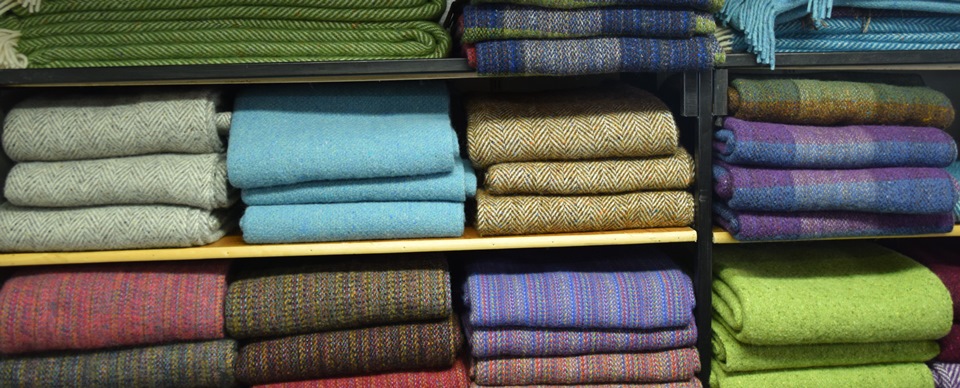
I love wool in all its forms—on the hoof, on the spinning wheel, on the loom, as knitting or crocheting yarn, or made up as garments or throws. I sometimes wonder if Ireland drew me to wool or the other way around. In yarn stores I can be found wandering from section to section touching the different types and brands or sniffing the lanolin in skeins of wool that have not been overly processed. I’m afraid I have a lot more yarn at home than I’ll ever get around to knitting up, but buying yarn always seems to be such a great way to take a little bit of Ireland back home with me.
Wool has amazing qualities that are not always recognized: it’s flame retardant, resistant to dust mites, and only extremely rarely allergenic, though most of us need a layer of cotton or some other fabric between our skin and the wool. Cool in the summer, warm in the winter, wool “draws moisture away from the body in the heat and maintains a layer of dry air around the body when the air is cool and damp” (see previous link).
Long before I started actually coming to Ireland, I learned to love the subtly multicolored wool made in Scotland and Ireland known as tweed, though I didn’t own anything made from it. Some sources connect the word “tweed” to the River Tweed in Scotland, but a more likely origin is a modified version, probably resulting from mistakes, of the fabric type “twill.” Authentic tweed comes mainly from Lewis, Harris, and Uist in the Outer Hebrides of Scotland or from County Donegal in Ireland, and the colors are all made with natural dyes. If you examine a piece of tweed or a strand of tweed yarn closely, you’ll see how complex the fibres are, with different colors of yarn woven together to support and deepen the overall color of the fabric, the so-called “heather” effect. Donegal tweed is particularly distinctive because of the small particles of color along the thread that add another dimension to the unmistakable “tweedy” look, the “Donegal” effect. I’ve knitted seven or eight sweaters with Donegal tweed; the colors come across differently with each stitch and make the project continually interesting, something a knitter always craves. You only have to look around you at the landscape of Ireland or Scotland to understand the inspiration for this compelling way of blending color.
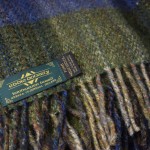 The other day I met one of the masters of the craft of handwoven tweed, Eddie Doherty, in his shop in Ardara, a remote village near the western coast of Co. Donegal. We had come to visit a well-known craft emporium up the street, but they seemed to be in the process of restocking, so after a short visit we walked on until the bright blue and yellow façade of Eddie’s shop and the stacks of colored fabrics I saw through the window drew me in. The others soon realized moving on was a lost cause and joined me in the shop. It was the last Friday in November, and though the sun was shining and the temperature mild, the village was very quiet that day, so Eddie had time to talk and to show us his wares. Greeting us with a smile and words of welcome, Eddie turned out to be as warm as the fabrics he creates.
The other day I met one of the masters of the craft of handwoven tweed, Eddie Doherty, in his shop in Ardara, a remote village near the western coast of Co. Donegal. We had come to visit a well-known craft emporium up the street, but they seemed to be in the process of restocking, so after a short visit we walked on until the bright blue and yellow façade of Eddie’s shop and the stacks of colored fabrics I saw through the window drew me in. The others soon realized moving on was a lost cause and joined me in the shop. It was the last Friday in November, and though the sun was shining and the temperature mild, the village was very quiet that day, so Eddie had time to talk and to show us his wares. Greeting us with a smile and words of welcome, Eddie turned out to be as warm as the fabrics he creates.
Before coming to Ardara, I had known of Eddie Doherty by reputation, but I didn’t know about his shop on the village’s main street, so meeting him was a delightful surprise. In addition to making fabric for items of his own, Eddie weaves the marvelous tweeds that the famous Magee company of Donegal Town has been making into men’s and women’s clothing since 1866.
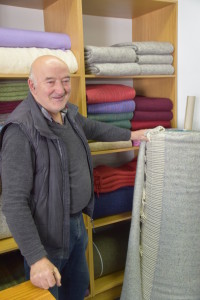 Eddie led us to the back room of the shop and immediately sat down at the loom to show us how it worked. He seemed to have all the time in the world to talk with us, laughing and joking as he sent the shuttle flying back and forth, pumping the foot pedals to regulate the pattern. The beautiful fabric on the loom grew as we watched. He was making one of the warm herring bone pattern blankets for which he is famous; this one was white, though with all the other colors in it, “white” hardly describes the fabric. The exclusive Cliff House Hotel in Ardmore, Co. Waterford stocks every room with Eddie’s blankets in green, blue, or pink. (Use that link to check out this stunning hotel literally perched on a cliff, and click on the “Rooms” tab to see Eddie’s blankets.)
Eddie led us to the back room of the shop and immediately sat down at the loom to show us how it worked. He seemed to have all the time in the world to talk with us, laughing and joking as he sent the shuttle flying back and forth, pumping the foot pedals to regulate the pattern. The beautiful fabric on the loom grew as we watched. He was making one of the warm herring bone pattern blankets for which he is famous; this one was white, though with all the other colors in it, “white” hardly describes the fabric. The exclusive Cliff House Hotel in Ardmore, Co. Waterford stocks every room with Eddie’s blankets in green, blue, or pink. (Use that link to check out this stunning hotel literally perched on a cliff, and click on the “Rooms” tab to see Eddie’s blankets.)
Eddie says it takes him most of the day to set up the loom for a project, with anywhere from 600 to over 1300 strands to thread in exactly the right order. Once that’s done, a blanket sized piece of tweed can be woven in less than an hour. Magee buys bolts of the fabric from him, but Eddie also manufactures the throws and other items for sale from his shop.
I didn’t want to leave the shop, but we had to move on, and fortunately Eddie told me that he would be in Dublin the next week for the annual National Crafts and Design Fair at the Royal Dublin Society, which I was already planning on attending. There were over 500 craft stalls and more than hundred artisan food producers at this wonderful event, held at the RDS at least since I started writing about traditional crafts in 1987. Between sales at his stall, Eddie and I continued our conversation about weaving. Even amid all that craftsmanship and the work of many other weavers and artisans, Eddie’s work stood out for its colors, textures, and designs, as I knew it would.
Eddie Doherty is one of a very few professional handweavers left in Ireland, so meeting him and watching him work was quite an honor. As he said to me, “No young people are learning this trade,” a sentiment echoed by the other weavers and salespeople I talked to in the “tweed” town of Ardara. Handweaving produces fine wool fabric of complex texture and depth of color that drapes in a distinctive way, and the Donegal version with its heathering and color flecks has no peer. It would be a terrible loss if this art were ever to disappear.

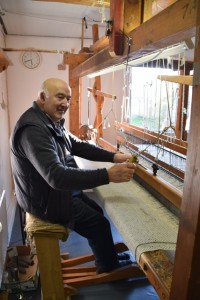
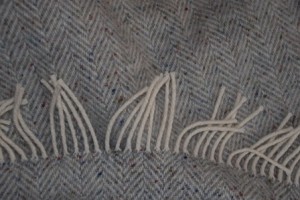

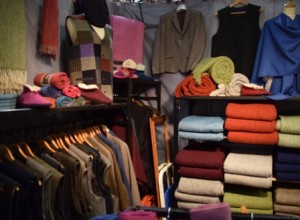
The very first sentence leaves out “on the grill” — in my view a serious omission that deserves attention in a (or maybe a few) separate post(s).
Ah yes…as a friend says every time we see a newborn baby lamb frolicking in the fields over here, “Mint sauce!”
I would like to purchase a throw but cannot seem to get to a website that will allow me to purchase one….not sure why.
I don’t believe Eddie sells online from his site. But you might check Magees Department Store in Donegal Town.